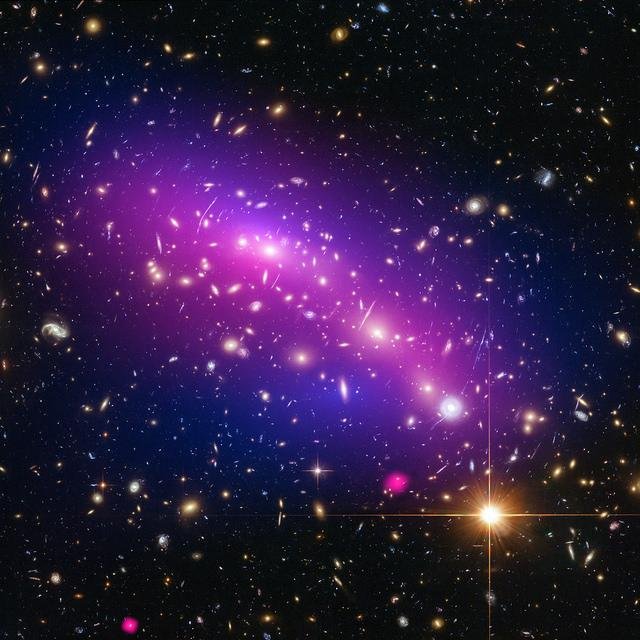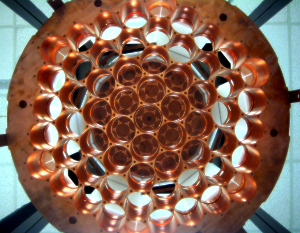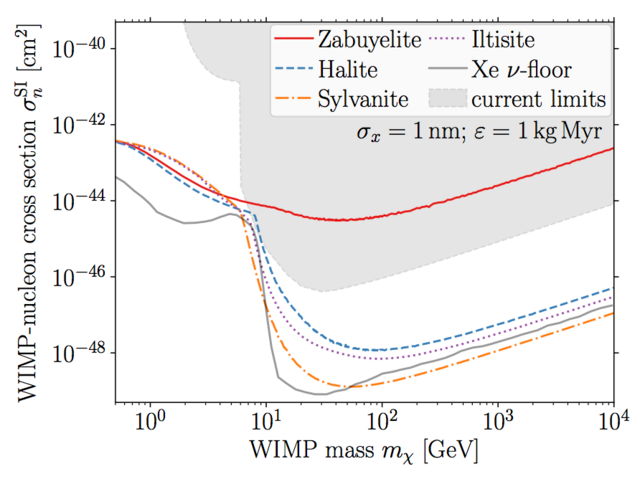Searching for dark matter with old stones
Identifying the nature of dark matter consists in one of the highest priority of particle physics today. Many different classes of experiments have consequently been built with this sole aim in mind.

[image credits: Smithsonian (public domain)]
Even if it is very elusive, dark matter can be directly observed in a detector placed on Earth.
By direct detection, I really mean it: I consider the detection of a dark matter particle hitting a detector and leaving a track inside it, such a track being measurable.
Many experiments have been built along this principle.
Although those experiments are doing extremely well, not a single dark matter particle has been observed today. Consequently strong constraints on dark matter can be derived from data.
Many viable options are nevertheless still viable, and all constraints can be accommodated in most concrete models.
A couple of weeks ago, an interesting research article have been released on the arXiv. It has shown that searching for hints of dark matter into million-year-old stones could yield better results than any state-of-the-art experiment.
DARK MATTER IN A NUTSHELL
The first question to address consists in the reason why most particle physicists bother about dark matter. It is pretty simple. If we take all cosmological data available today, we have (indirect) evidence that most matter is invisible.
In other words, one needs dark matter to make cosmological observations matching theory.
This being said, it is also possible to change the theory and get rid of dark matter. We could for instance modify how gravity works. However, the significance that we get at the end of the day is not as strong as with dark matter.

[image credits: ESA]
For this reason, I personally prefer the dark matter paradigm. Other researchers nevertheless investigate alternatives. What matters is to ensure that there is no potential loophole in the searches.
Cosmological data thus indirectly provides evidence that matter is mainly of an unknown nature.
But what is the definition of dark matter? Actually, its name is well chosen. Dark matter contains the two words ‘dark’ and ‘matter’.
Dark matter is dark because it does not interact electromagnetically. Knowing that the particle responsible for mediating the electromagnetic interactions is the photon, or the particle of light, I guess it is easy to connect the dots.
Moreover, dark matter behaves gravitationally as normal matter. Therefore, dark matter is a kind of matter too. Once again, easy to connect the dots.
DARK MATTER DIRECT DETECTION
As said in the beginning of this post, dark matter direct detection experiments aim to observe dark matter when it travel through Earth. They rely on the fact that dark matter can potentially interact with the material of a detector when it goes through it, and thus be observed.

[image credits: LUX]
Of course, the probability with which a dark matter particle going through Earth would interact with anything is tiny.
There is however one way out, which consists in building a very large detector to maximize the chances of observing anything.
An example of such is shown on the picture on the left. The detector is full of material which dark matter can interact with, and surrounded by electronics allowing to record what is going on.
Whilst in most cases dark matter will just go through the detector undisturbed, once in a while it hits an atomic nucleus from the detector material.
The recoil of the nucleus can be observed and the properties of this recoil can be measured. This offers a way to detect dark matter. The caveat is as usual the background, coming mostly from electronic recoils and neutron contamination. However, it can be at the end of the day controlled.
As dark matter direct detection experiments have not been able to observe any dark matter particle up to now, we can interpret the results under the form of constraints on dark matter models.
In particular, the interaction rate of dark matter with the nucleus is more and more constrained. It must indeed be small enough to guarantee the fact that the dark matter direct detector experiments do not observe anything. Taking all data into account, we are however still far from a complete exclusion of dark matter.
PALEO-DETECTORS
In this scientific article that appeared a couple of weeks ago, a group of researchers have introduced a new tool to search for dark matter. The idea is to move away from standard dark matter direct detection experiments. I recall that the latter must be built from a huge amount of very pure material to ensure a large enough detection probability, and well shielded to be able to control background.
The authors of the above paper proposed instead to use very ancient minerals as dark matter detectors. The heart of the proposal consists in investigating how these stones could contain a persistent chemical or structural change caused by a dark matter particle hitting one of the atomic nuclei of the stones.
Such a change could be observed, with a very good precision, through electron microscopy or atomic force microscopy, as well as with more recent 3D imaging technologies (using X-rays or ultraviolet light).
In order to reduce the background, there are once again constraints on the type of minerals that should be used. The authors have shown that a dark matter signal could be extracted from the background by relying on specific classes of minerals older than about 500 million years, also known as paleo-minerals. The four considered examples are Zabuyelite, Halite, Iltisite and Sylvanite.

[image credits: arXiv]
The results that are shown on the figure on the right have been obtained with a few grams of paleo-minerals.
The figure shows the constraints on the dark matter interaction rate with a nucleon (the y-axis) relatively to the dark matter mass (the x-axis).
The grey region is excluded by all direct dark matter experiments run up to now.
The four dashed lines depict how the grey zone would expand by probing each of the four minerals above-mentioned.
Comparing the grey zone to the position of the dashed lines, it is clear that dark matter models could be in a very critical shape thanks to this new method, the white zone being the region still allowed by data.
SUMMARY AND TAKE-HOME MESSAGES
I detailed a very recent research article proposing to search for dark matter in very old minerals known as paleo-minerals.
By using million-years-old minerals (Zabuyelite, Halite, Iltisite and Sylvanite) that are very easy to get in cores from ultra-deep boreholes, it has been shown that constraints on dark matter could be increased to a very large extent. In particular, the rate at which a generic dark matter particle could interact with normal matter could be constrained two or three times more stringently than what it is today.
This new method using rocks offers thus existing prospects for the future.
STEEMSTEM
SteemSTEM is a community-driven project that now runs on Steem for almost 2 years. We seek to build a community of science lovers and to make Steem a better place for Science Technology Engineering and Mathematics (STEM). In particular, we are now actively working in developing a science communication platform on Steem.
More information can be found on the @steemstem blog, in our discord server and in our last project report.
I guess here that in order to build a dark matter detector or to examine ancient minerals to find clues about dark matter, scientists must make some educated guesses with regards to the possible nature of dark matter?
Are there different schools of thought and political trends with regards to what dark matter might be and, as a result, unlock budgets to conduct investigations in one direction or another?
This is correct. Here we assume that dark matter is a weakly-interacting massive particle (aka a WIMP). This is one of the most popular choice for a dark matter candidate, although there exists hundreds of them :)
There are a couple of main paradigms plus really hundreds of different models. The nice point is that the amount of observable signatures is not that large at the end of the day. What is important is that all options are covered. And we hope they are.
Politics does not really matter here. Moreover, with the absence of results, physicists are thinking hard about proposing new ideas.
On the other hand. experiments targeting new options are proposed and some of them are built.
Have any of the neutrino detectors around the world seen odd signals that can't be explained? (i.e. an interaction with dark matter.)
Neil de Grasse Tyson likes to use the term 'Dark Gravity' as the term 'Dark Matter' is leading people to a conclusion. Why do you think about that, if anything?
No(t yet). Some neutrino detectors (but not all) can in principle detect dark matter, but nothing has been found yet. One hope lies in the DUNE experiment.
What is dark gravity? This does not ring any bell to me. After googling it a little bit, it seems to be just one of the numerous dark matter models. But I didn't dig into it so that I won't be able to say more.
Thanks for the reply, I was kind of expecting that answer.
'Dark Gravity': Neil Tyson in this Big Think video here at around 50 seconds into the video. Basically just a pedantic complaint about the 'dark matter' label.
Well, you can like dark matter or not. It nevertheless helps to explain cosmology pretty well. Much better than any other alternative. Now, since we have not discovered it, alternatives are possible. But saying that the dark matter paradigm is wrong is just an unfounded assumption. The good answer is "we don't know yet". :)
astrophysics for people in a hurry, i found the book most enlightening for a layman like myself
You said dark matter can change or modify gravity! Is it possible for dark matter to reduce gravitational force after being modified?
This was not clear in my post and I have now fixed it. Modified gravity is an alternative to dark matter. Under its simplest form, those theories modify Newton's laws at large distances. Note that you could build theories (and this is done) featuring both dark matter and modified gravity.
Is it clearer now? And thanks for the question by the way! ;)
Yes, well understood! And thank you for making it clearer.
My pleasure ^^
Spot on! I will hang on here to see how @lemouth gonna respond to this question. The question almost came from me...
The answer has been given below. Thanks for the question! ;)
✌️✌️
Hey @lemouth!
I must say I already learned something new in the first two lines. What kind of material is being used in such detectors and how do we explain the fact that dark matter particles only interact with the detector material once in a while?
So they basically estimate the dark matter interaction relatively to the dark matter mass? Is that how dark matter models are created?
Thanks for another interesting read!
Thanks for those very nice questions!
Dark matter must be very weakly interacting with the Standard Model. Therefore, it must be very weakly interacting with normal matter (made of standard model particles). However, "very weakly" does not mean "not interacting". The interactions are super rare, but they happen. By constructing a super large detector, we hence multiply the chance to have such interactions.
The best current choices are detectors mande of xenon gas. You can for instance see here. The xenon-1T (1T stands for 1 ton) experiment has recently released its new results.
It works both ways. By the size of the limits for a given mass, we can have some idea about what makes a model viable. In the other way round, when starting from a model, we can predict the production rate. `the main dependence of the production rate comes from the dark matter mass, which explain the chosen representation for the results.
Is it clearer? :)
Thanks for another great article. We haven't observed any interactions between dark matter and normal matter, so I don't understand how we can be sure that interactions do in fact happen?
We construct models to explain the observations, and these models predict that to some extent, dark matter interact with normal matter. There is no way out if one wants to reproduce data. Those interactions are very weak, but they must be there.
I understand, thank you for the explanation
You are very welcome! :)
It is a lot clearer now, thanks for taking the time to provide detailed answers! Have a great day!
Thank you! I always take the time to answer, even if the answer may be delayed a little bit. Have a good "whatever" (it is night at the moment) as well :)
Someone is gonna twist this and say that "quantum science proves ghosts exist", just you wait...
I like the new 'Stoner' approach. It's more practical it seems to me, and cheaper. It reminds me of how scientists used to do physics without all the fancy equipment used today. (Well, the rock experiment would still require fancy equipment, but it's normal by today's standards.)
Beware of heavy jargon usage: ghosts are necessary in certain gauges... Fadeev-Popov ghosts are necessary in practical calculations. Of course, this is different from the ghosts you had in mind, and this has also nothing to do with dark matter ;)
It is indeed very cheap. We can just use existing boreholes, and the necessary microscopes are also somehow standard.
We have the technology built-in. However humans are far away from this type of matter, as we're still mostly in the dense~matter...
...btw.. I have a friend here in my hometown, who is theoretical and quantum physicist and we ofter discuss such topics...
I myself have never touched the "real" proof, cause I only travel by soul :)
Well, we are studying and learning. That's the all process here :)
Using ancient stones to detect dark matter? Sounds fascinating.
Does it mean that archaeology, history, and paleontology is somehow connected to particle physics?
Somehow, yes :)
Indiana Stoner?
Now I have a stupid music in my head ;)
everything is particle physics ... psychology is particle physics, construction work is particle physics, they're all just subsets of the sons and daughters of Newton ... basically but no one would like to hear it like that unless their field is physics hahah
Hi @lemouth! How are you? After a long time!! :)
Wow!! This article is a real treasure for me.
Amazing information!! Thanks for sharing this link. I will love to explore the resources you provided to explore more.
But further more your article is more easy in understanding from their and in a more detailed manner!!
Loved your article and came to learn so many new things here. :)
Wishing you a very harmonious days ahead!! :)
Yes, I am very busy those days, helping African students and thus barely online. This also explain why I was not so present for a week, and will be barely present during the next 7 days.
Thanks for your nice message! :)
You are most welcome!! :)
Hi @lemouth!
Your post was upvoted by utopian.io in cooperation with steemstem - supporting knowledge, innovation and technological advancement on the Steem Blockchain.
Contribute to Open Source with utopian.io
Learn how to contribute on our website and join the new open source economy.
Want to chat? Join the Utopian Community on Discord https://discord.gg/h52nFrV
almost a 1000 votes :p ... moving on up in the world
i try my hand at the paper you linked by i quite soon have to admit its mostly slightly above my braingrade lol, leaving out the symbols i cant read and the formulas used i get to about one word per sentence i would need to google and study by itself ... doppler effects ... mössbauer effect , nuclear recoil , the name WIMP is funny though , weakly interacting, someone must have had a lol there ...
I got as far as understanding they reduce the cost by a magnitude of several zeroes by removing the need to shelter from this cosmic background, and that is why detectors are built deep underground (leave me asking the same as those neutrinos though, if a ray can pass through the planet whats the point of a few kilometres of rock in between ? does that REALLY help ?).
They actually try to use a system that removes the whole problem of this background noise ? In some way they check the result of cosmic baseball, a gamma ray fired from the other side of space hits an atom here and the core gets pushed back (a microscopic bit) and in some way this leaves a trail that can be detected 500 million years later ?
now we're seriously above my braingrade lol, then after reading your explanation i think i'm not far off the mark with my interpretation but what i still dont get is how a gamma ray hitting an atomic nucleus out of its location leads to detection of dark matter ?
where does the dark matter come in to play here, thats not completely clear ?
i know its not an active post but im totally catching up with everything as much as i can ... if you find time , (and i know you always try) i would be much obliged as always.
cosmic baseball on 500 million year old stones instead of burrowing miles into the earth
sounds like creative use of resources to me (i think i understand that much so far :p)
fascinating "matter" as always, i think i might have to clone myself to keep up with everything here on steemit by now ... you don't have any mad frankenstein geneticists in your #steemstem team you could recommend by any chance?
Neutrinos will interact too and leave track too. But this is even more rare than dark matter.
Dark matter travels within the universe, and dark matter is supposed to constantly go through Earth.
Mmmhhh... try @mobbs :D
@mobbs ... #steemstem manager from China ...
topmost post the history of death by sawing
yea i think we could probably get along, thank you for the directions
thank you for the directions
so dark matter is like neutrinos in the way that its constantly everywhere, it goes through about everything and they are both (so far) undetected but theoretically they make the gaps and the 94% of reality that's missing work
it's like the more i understand the less i get it :p
but i'm not one to quit something i chose to do , thank you again for taking time, i hope you're enjoying the summer a bit , can't always be strung up (sounds bad literally translated hmmm)
but the technique described does remove the need to worry about the background noise, doesn't it ? since they measure trails in the rock that are there , etched for 500 million years, it doesnt matter how many invisible particles and obscure stuff shoots through or near it at the time of examination
once again pardon my lack of scientific lingo, im actually quite amazed i could make out the meaning of that paper, its a bit of a problem googling these things, you often get links to places like Cornell and those papers arent really written for the people, are they ?
much obliged
No, neutrinos are detected and observed. Dark matter is not.
There is always some background, and we can always control it to some extent. This yields some error bar on the result.
you mean in this case statistical noise thats "etched" in the same stones together with impact on the core (the nucleus?) and the distance it moved i suppose ? i didnt think of that :)
thats why you're the physicist i guess, thanks a lot for replying every single one again !!!
We are always expecting some background. Some of them can be controlled (i.e. rejected by cleverly investigating what is going on), some of them can't (and his will give rise to some limitations in terms of sensitivity).
with every generation there will be fresh minds who make like paracelsus and tear up the books after reading, come up with new ways to apply old theories or tweak it a little to make it work , and most important, are more able to use whatever is at hand creatively since they were born in the now
thats just how it goes i suppose, we can only hope it happens in our lifetime
or aubrey de grey finds a way :) , thats my mad frankenstein right there
thank you again and have a nice day, -sensei